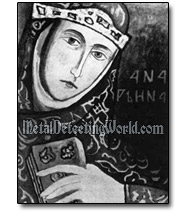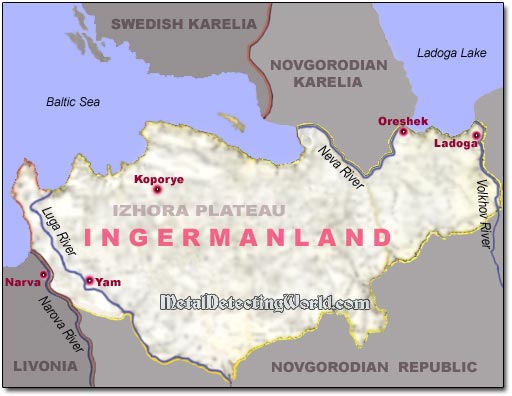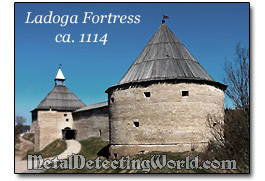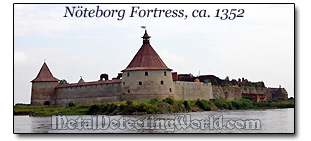Part I - Metal Detecting at the Swedish Tavern Site, page 3
Novgorodian Ingermanland (Ingria) and Its Fortified Centers in Medieval Times

The ancient Novgorodian land of Vod was called "Ingermanland" by the Swedes, latinized to "Ingria" (Inkeri or Inkerinmaa in Finnish, Ingeri or Ingerimaa in Estonian). The name is traced to Ingegerd Olofsdotter (1001 - 1050), a Swedish princess and a Grand Princess of Kiev. She was the daughter of the Swedish king Olof Skötkonung who ruled from 995 to 1022.
Upon her marriage to Yaroslav I the Wise in 1019, she was given the lands around Lake Ladoga as a marriage gift. They were administered by Swedish jarls - members of medieval royal families, under the sovereignty of the Novgorodian Republic.
In the 12th century, the rich and populous area between the rivers Luga and Izhora was absorbed by the Novgorodian Republic. By the end of the 14th century, there were four administrative centers with citadels in Ingermanland: Ladoga, Koporye, Oreshek (Orekhov) and Yam.
Novgorodian Ingermanland in 15th Century


Located on the eastern border of Ingermanland - on the right bank of the Volkhov river, Ladoga is an oldest city in Russia. It was founded on the famous trade route from "Varangians to Greeks" in 753, and was first mentioned in ancient annals in 862. In the 8th and 9th centuries, this place was a prosperous trading outpost with numerous fairs, crafts, trades, etc., and the capital of Russia for a short time.
In the 10th century, the capital was moved to Novgorod for political reasons. In the 12th and 13th centuries, Ladoga still functioned as a trade outpost of the powerful Novgorod Republic. Merchant vessels sailed from the Baltic Sea through Ladoga to Novgorod and then to Constantinople or the Caspian Sea, all the way to Baghdad. The oldest Arabian coin in Europe was dug up in Ladoga.
Erected in 1114, the Ladoga fortress was the first stone fortress in Russia. The fortress changed hands a few times over the 500 years period, but remained under Russian control most of the time. After new fortresses such as Oreshek and Korela (Kexholm) were constructed in the 14th century, the town's trade and military significance decreased. In 1704, the local administration and trading were moved to the small town Novaja Ladoga (New Ladoga) near the Ladoga Lake under the order of Peter The Great. The ancient city faded away in 1860s when the construction of railway stopped the trading transportation over the river of Volkhov.

To guard the northern approaches to Novgorod and access to the Baltic Sea, the Novgorodians built the fortress Oreshek ("Nut") on Orekhovets Island at the head of the Neva River on Lake Ladoga in 1323.
Swedish King Magnus Eriksson attacked and briefly took the fortress during his crusade in the region in 1348. It was largely ruined by the time the Novgorodians retook the fortress in 1351.
Being an important fortress dominating the entrance to Lake Ladoga, it was rebuilt in stone in 1352. The fort was captured by Sweden in 1611 during the Ingrian War. As a part of the Swedish Empire, the fortress was known as Nöteborg ("Nut-fortress") in Swedish, and became the center of the north-Ingrian Nöteborg county. In 1702, the fortress was taken by Russians under Peter the Great and given its current name, Shlisselburg (Schlüsselburg - "Key-fortress" in German). The name refers to Peter's perception of the fortress as the "key to Ingermanland".